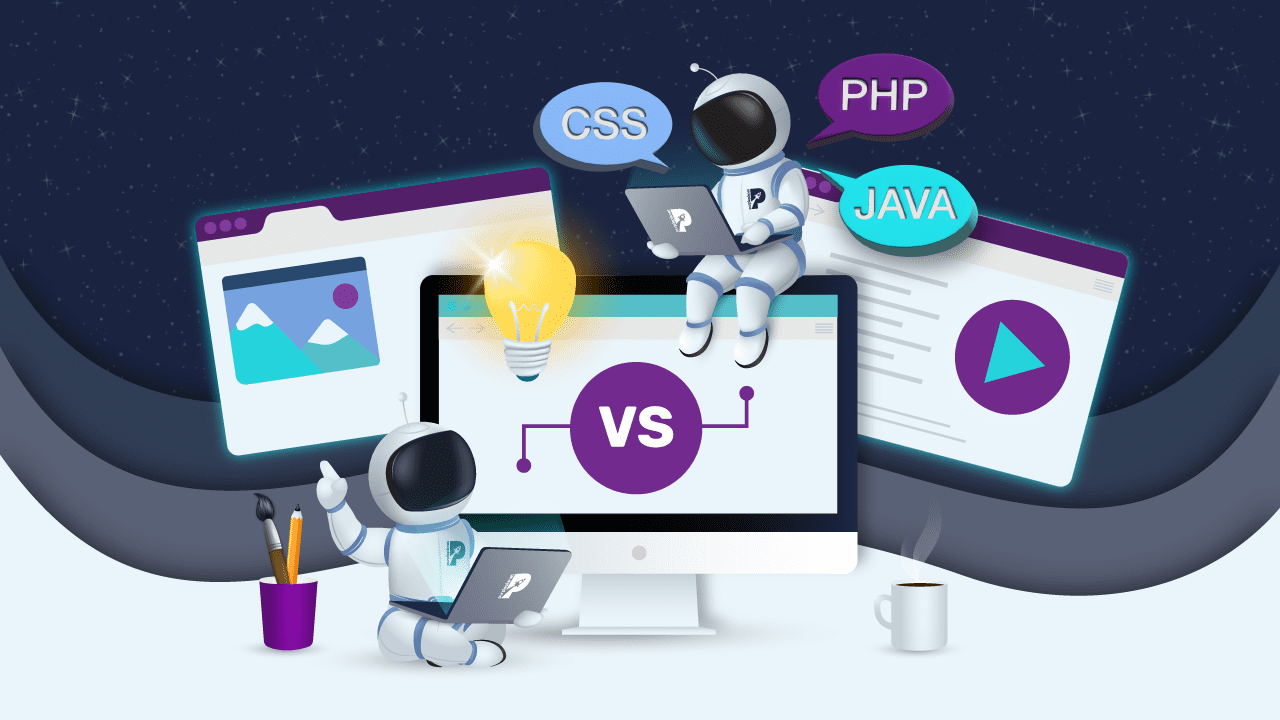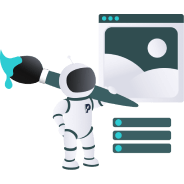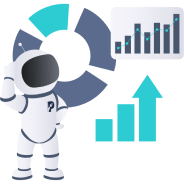

Web Designer vs. Web Developer: What’s the Difference?
Are web development and web design the same?
Web development and web design are not the same – they’re actually very different fields within the realm of digital work. Although both work with websites, a web developer will build and maintain them whilst a web designer will design their visual and useable elements. Developers are more concerned with structure and function, while designers focus on useability and aesthetics.
This article will explain these roles, their different types, and their respective required skills. You’ll also learn about their salaries and how you can become qualified to work in either field.
Plus, if you’re looking to hire a web developer or designer, this article will enlighten you about what you should expect from a contractor so you can get the best out of your working agreement.
Firstly, let’s take a look at web developers.
Web developers can be categorised into three main types:
- Front End Developers
- Back End Developers
- Full Stack Developers
Front-end web developers will often collaborate with web designers as their role largely involves the programming and coding of the visual elements seen by site visitors. Front-end developers will code the website using HTML, JavaScript, and CSS (as well as other languages).
Back-end web developers will code the server and database with more advanced programming languages (e.g., Java, Ruby, PHP, C#, SQL, and NodeJS). The outcomes of back-end development work aren’t seen by website visitors but instead form the essential “behind the scenes” action.
Full-stack developers can do both front and back-end web development as well as set up and configure servers and code Application Programming Interfaces (APIs).
What skills do web developers need?
- Analytical and problem-solving skills.
- Be able to code and program in languages such as CSS, HTML, JavaScript, and PHP.
- Understand frameworks such as jQuery.
- Be able to conduct tests and debug sites.
- Use Chrome DevTools.
- Understand databases
- Be proficient in Content Management Systems such as WordPress.
- Understand the importance of SEO and the role web development plays in it.
- Use File Transfer Protocol and hosting control panels.
- Ability to collaborate with other team members and clients.
- Maybe use tools and platforms such as GitHub or Jira.
Now we’ll look at the role of a web designer.
There are three main types of web designers:
- UX Designer
- UI Designer
- Visual Designer
UX designers, as the name suggests, are involved with “User Experience.” This means their design work is intended to guide, engage, and nurture site visitors to remain on the site, navigate it easily, and ultimately make a purchase. UX designers will use data to make design decisions that are proven to positively affect the goals listed above. UX deals with the users’ experiences more generally than UI design, though both strive to provide a positive experience.
UI designers deal with the interactions users have with software, computer systems, and applications. UI, standing for “User Interface,” means these designers are more focused on making users’ experiences more intuitive through the use of colours, buttons, and icons.
Visual designers aim to make websites easy to use and aesthetically pleasing. Their work will use elements from both UI and UX design.
What skills do web designers need?
- Use design and editing programs and software such as Photoshop.
- Use image compression and optimisation tools.
- Comfortable with using Content Management Systems such as WordPress.
- Proficient in colour theory, branding, and typography.
- Understand web accessibility standards.
- Knowledge of CSS and HTML.
- Understand user journey mapping.
- Comfortable with Conversion Rate Optimisation (CRO).
- Knowledge of interaction and responsive design.
- Understand prototyping and wireframing.
Evidently, designers and developers use different tools and work in different ways: whilst designers work with concepts and visual ideas, developers must use technical and practical methods to complete their tasks.
How do designers and developers collaborate?
When web designers come up with artistic ideas, they’ll create a mock-up and send this to the web developers. The developers will scrutinise this mock-up to determine its plausibility – technically and financially. There might have to be a bit of “back and forth” before both parties are satisfied.
Once the mock-up is deemed suitable, developers will program and code the site to match the designers’ ideas.
Though their daily tasks look very different, these two roles must learn to work together if they are to create a high-quality end result. Both design and development are essential for producing smoothly running and aesthetically pleasing websites that provide visitors with positive experiences.
Who earns more: web designer or web developer?
When thinking about the web designer vs web developer salary, it really comes down to the number of years worked (i.e., the experience), the variety of projects that make up one’s portfolio, and the proficiency to complete a service to a high standard.
Despite the statistics that follow, the above factors are much more important in determining the kind of money you can make as a web developer or designer.
On Upwork, both web developers and web designers can be seen to charge between $25 and $150 per hour.
According to Indeed, the average UK web developer’s yearly salary is £36,906, with London workers earning an average of £52,751 per year. Meanwhile, Kinsta reports web developers earn, on average, $69,430 before taxes in the US. Across Europe, Devox Software reports web developers’ yearly salaries ranging from $39,682 (Belgium) to $123,947 (Denmark). So, evidently, it really depends on where you live.
Thinkful reports the average US salary for junior web designers lies between $42,000 and $62,000, whilst Prospects states UK web designers might begin on a yearly salary of £24,000 and earn upwards of £45,000 per year in senior roles. European web designers are best off working for Swiss, German, and Swedish clients, as Hongkiat reports, with annual salaries in these countries reaching $77,000, $47,000, and $43,000, respectively.
Evidently, different sites report different rates, which makes it difficult to be specific about salaries. Comparatively, though, starting rates tend to be higher for web developers due to their highly-prized coding skills – an essential ability in today’s digital landscape. Nevertheless, both types of contractors can make decent money once they’re well-established.
Furthermore, since many developers and designers are freelance, their success will also depend on their ability to adapt to the demands of self-employment. These demands will vary from being able to self-motivate, promote themselves, figure out their taxes, and balance work from multiple clients.
Affording a designer or developer
How can companies hire talented contractors within budget?
It’s common for companies to outsource web development and design work to personnel living in poorer countries, as they tend to produce high-quality work for considerably lower rates than those living in wealthier countries.
One side effect of this pattern lies on the contractors’ side of things. Workers from all over the world might find themselves in a highly competitive jobs market as they’re being undercut by talented workers selling their services for cheaper. Of course, this is the nature of the gig economy; developers and designers are not exempt from the issues it poses.
Designers and developers in this situation can prove their worth by building a list of satisfied clients, a professional-looking website, and an impressive portfolio.
If you’d like to hire a high-quality developer or designer, but you’re on a budget, you shouldn’t expect it to come cheap. These workers spend years honing their skills, and if you want to hire someone with a track record of good results, then it’s going to come at a higher cost.
Though you can outsource workers from poorer countries, your rates shouldn’t be so low that they’re disrespectful. Professional design and development work are prized and hard-earned, and your budget should reflect this. If you invest in someone at a fair rate, you’ll see an even bigger return.
Since many business owners don’t have web development or design skills of their own, outsourcing is an inevitability. But since these roles can have hugely positive impacts on SEO, user experience, and website function, their value can’t be underestimated.
Can a web developer also be a web designer?
Technically, a freelancer can offer a variety of different services to their clients, and it’s very common for web developers and designers to undertake this type of employment rather than more conventional channels.
However, as discussed above, these two job roles have very different skill requirements. Web developers tend to be more analytical and enjoy the technical aspects of their jobs. On the other hand, web design can attract creative people despite there being some technical elements to the role.
Web designers will never have to master complex programming languages, and web developers aren’t expected to have an artistic side.
Most individuals will be better suited to one or the other – rarely both. Plus, mastering one skill is difficult and mastering two is almost unheard of.
Nevertheless, if you find that your analytical and creative sides are fairly balanced and that you’ll enjoy both – why not go for it? Freelancers that sell a variety of services can be extremely productive since their work is varied and rarely monotonous.
If you’d like to pursue one or both of these roles, read on to learn how to get started.
Pursuing a career in web development or design
If you like the sound of both careers but can’t decide which one to go for, why not take a web developer or web designer course? Then you can make an informed decision after experiencing both and choose the one you enjoy most.
If you’re investigating how to become a web designer, you might like to do an intensive course. Some of these take only twelve weeks to complete, and participants leave them ready to take on design jobs.
Learn how to use the tools
Newbies will want to familiarise themselves with web design tools such as InVision Studio, WordPress, Sketch, Google Web Designer, Dreamweaver, and Photoshop.
Study web design theory
Web design theory will teach the fundamental principles of creating great sites. These principles include things like:
- Colour theory
- User experience
- User navigation
- Website purpose
- Use of typography
- Use of imagery
- Importance and implementation of visual hierarchy
- F-Shaped pattern reading
- How different devices (e.g., computers and phones) change aspects of web design
Create a portfolio
Once you complete your course in web design, understand the fundamental principles, and can find your way around some essential tools, your next step will be to build a portfolio.
Putting your newfound knowledge into practice will help sharpen your skills as well as creating a portfolio of work you can show to prospective clients.
Apply to jobs
Your next step will be to apply for jobs and start work as a web designer! You can go freelance or choose to work in-house or via an agency, and choose between UX, UI, and Visual Design.
Those who want to learn how to become a web developer fast might opt for a coding boot camp since these can teach skills very quickly.
Learn coding languages
Newbies should learn the fundamental aspects of web development, beginning with coding languages such as CSS, HTML, and JavaScript.
Choose a specialism
Choosing a specialism will determine your next steps. Would you like to be a front-end, back-end, or full-stack developer? Front-end developers should learn about a site’s design and layout, as well as how visitors interact with it. Comparatively, back-end developers should learn about how sites function – networks, hosting, databases, and servers. Those who wish to pursue full stack development will have to learn both.
Learn about web design
It’s helpful if developers (especially front-end developers) have some web design skills. Though you won’t be asked to design entire websites, understanding the fundamental principles of web design will give you a tighter grasp of what constitutes user-centric development and design.
Learn the “hard” skills
When you’re a specialist, you can choose which programming languages to use depending on what works best for you. But before you reach this stage, you’ll have to do a lot of practice. Messing about with coding and websites will improve your skills. Soon, you’ll learn the “hard” skills such as programming in Python or SQL. You’ll learn to use the jQuery library of functions and Git.
Build a portfolio
Before you can land those high-value clients, you’ll have to build a portfolio. Try to make it as diverse as possible to show you’re versatile. Your work should demonstrate your solid understanding of the different aspects of web development, but it doesn’t have to list every job you’ve ever worked on.
When you apply for different jobs, you can adapt your portfolio to suit the client. After a little research, you should understand what they’re looking for and edit your portfolio so that it appears as relevant as possible.
Keep up with industry changes
Since things can change in the web development world – i.e., tools, trends, and programming languages – web developers must keep up. This might involve retraining or simply keeping an eye on changes via forums.
Should I hire a web developer or a web designer?
If you need to hire a developer or designer, you have the budget, and don’t want to do it yourself – then you should! You’ve probably already worked out which one you need from the information above, but put simply:
You’d hire a web developer if you’re having problems with the function of your site. Maybe it’s running slowly, you’ve got bugs, or you’d like to re-develop the entire thing. If you’ve got a mock-up from a designer, you’d hire a developer in this instance to make the mock-up a reality.
You’d hire a web designer if you want to rebrand or make your site more user-friendly. If you’ve had feedback that said your site wasn’t very trustworthy, then you’d hire a designer to improve this.
Benefits of hiring a web developer:
- They’ll lay out a strategic plan
- High-quality web development can have a positive impact on SEO
- They can be on hand to fix problems when they arise
- Saves time
- Improved website speed
Benefits of hiring a web designer:
- Your website’s design will be high-quality and user-friendly
- User-friendly web design can massively benefit SEO
- They’ll make your site compatible with different devices
- Saves time
- They’ll keep your site up to date and trendy
- Good web design means customers trust you
Now that you know the differences between these two skills, your next steps will either be to start the hiring process or to pursue courses to become qualified in one of them.
If it’s the former, you might like to hire purpleplanet for your development or design needs. Our team is made up of only experts in their fields and our 17 years of experience means you’ll get only the best high-quality digital services. Click below to read more about us and our services.
[sc name=”contact_us” ][/sc]











